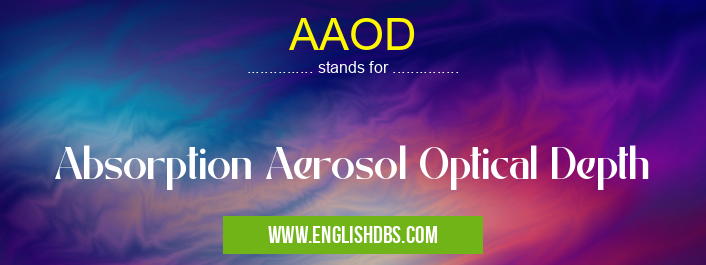What does AAOD mean in UNCLASSIFIED
AAOD stands for Absorption Aerosol Optical Depth. It is a measure of the amount of light that is absorbed by aerosols in the atmosphere. Aerosols are tiny particles of matter that are suspended in the air, such as dust, smoke, and haze.

AAOD meaning in Unclassified in Miscellaneous
AAOD mostly used in an acronym Unclassified in Category Miscellaneous that means Absorption Aerosol Optical Depth
Shorthand: AAOD,
Full Form: Absorption Aerosol Optical Depth
For more information of "Absorption Aerosol Optical Depth", see the section below.
Aerosols can have a significant impact on the Earth's climate. They can scatter and absorb sunlight, which can lead to changes in temperature and precipitation patterns. Aerosols can also affect the formation of clouds and the amount of water vapor in the atmosphere.
AAOD is an important parameter for understanding the role of aerosols in the climate system. It is used in climate models to simulate the effects of aerosols on the Earth's atmosphere. AAOD can also be used to monitor the concentration of aerosols in the atmosphere and to track the transport of aerosols from one region to another.
Essential Questions and Answers on Absorption Aerosol Optical Depth in "MISCELLANEOUS»UNFILED"
What is Absorption Aerosol Optical Depth (AAOD)?
AAOD is a measure of the amount of sunlight absorbed by aerosols in the atmosphere. Aerosols are tiny particles suspended in the air, such as dust, smoke, and sea salt. When sunlight passes through the atmosphere, some of it is scattered or reflected by aerosols, and some of it is absorbed. AAOD quantifies the amount of sunlight that is absorbed by aerosols, which can affect the Earth's climate and air quality.
What units is AAOD measured in?
AAOD is typically measured in units of dimensionless optical thickness. This means that it is a measure of the fraction of sunlight that is absorbed by aerosols.
How is AAOD measured?
AAOD can be measured using a variety of instruments, including sun photometers, satellite remote sensing, and airborne sensors. Sun photometers measure the amount of sunlight that is scattered or reflected by aerosols at different wavelengths. Satellite remote sensing can be used to measure AAOD over large areas, and airborne sensors can be used to measure AAOD at different altitudes.
What factors affect AAOD?
AAOD is affected by a number of factors, including the size, shape, and composition of aerosols, as well as the wavelength of sunlight. Larger aerosols tend to absorb more sunlight than smaller aerosols, and aerosols that are composed of absorbing materials, such as black carbon, tend to absorb more sunlight than aerosols that are composed of non-absorbing materials, such as sea salt. The wavelength of sunlight also affects AAOD, with shorter wavelengths being more strongly absorbed than longer wavelengths.
What are the implications of AAOD?
AAOD can have a significant impact on the Earth's climate and air quality. Aerosols that absorb sunlight can warm the atmosphere, while aerosols that scatter sunlight can cool the atmosphere. Aerosols can also affect cloud formation and precipitation, and they can be harmful to human health.
Final Words: AAOD is a valuable tool for understanding the role of aerosols in the climate system. It is used in climate models, air quality studies, and atmospheric remote sensing. AAOD can help us to better understand the impacts of aerosols on the Earth's climate and to develop strategies to mitigate their effects.
